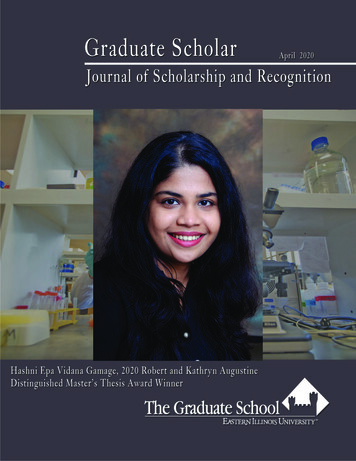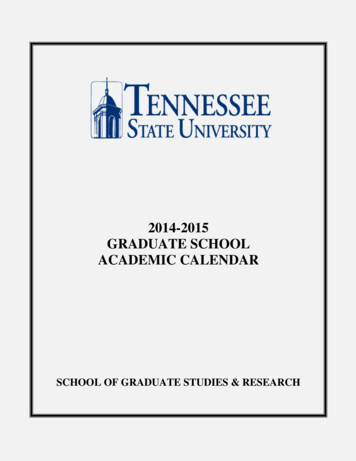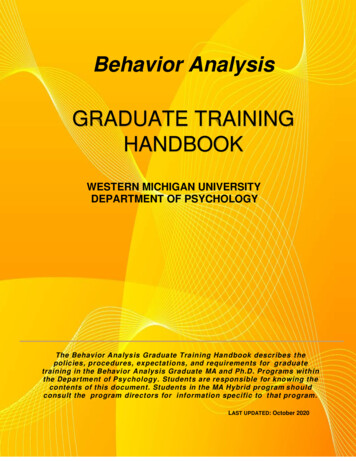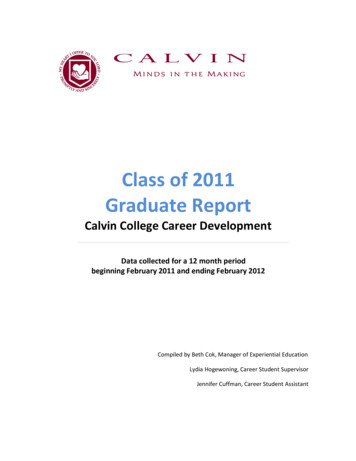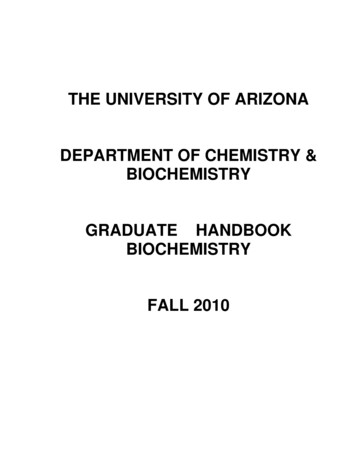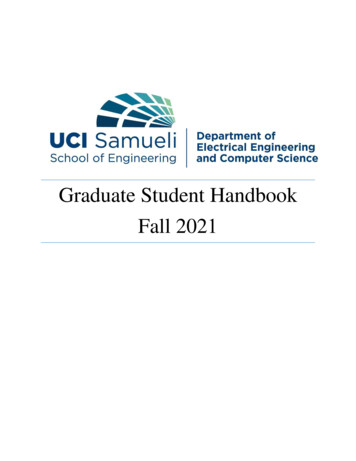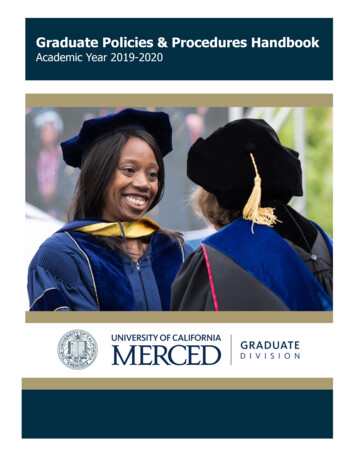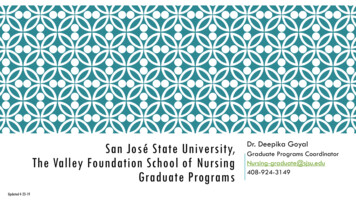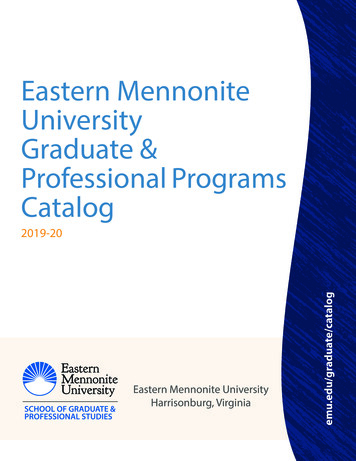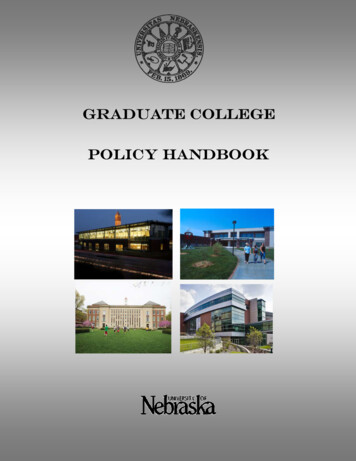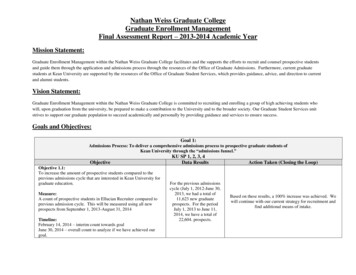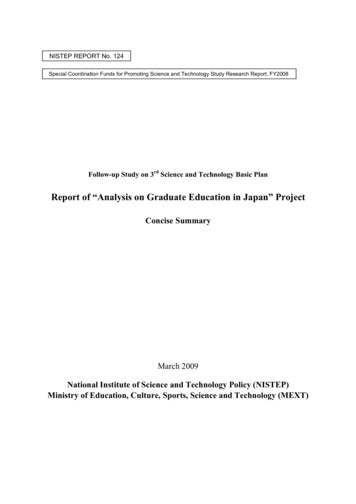
Transcription
NISTEP REPORT No. 124Special Coordination Funds for Promoting Science and Technology Study Research Report, FY2008Follow-up Study on 3rd Science and Technology Basic PlanReport of “Analysis on Graduate Education in Japan” ProjectConcise SummaryMarch 2009National Institute of Science and Technology Policy (NISTEP)Ministry of Education, Culture, Sports, Science and Technology (MEXT)
Concise Summary of “Analysis on Graduate Education in Japan” ProjectMarch, 2009National Institute of Science and Technology Policy (NISTEP)Ministry of Education, Culture, Sports, Science and Technology (MEXT)JAPANThis report summarizes the results of “Analysis of Graduate School Education (PR8)” (FY2008) from thefollow-up research on the 3rd Science and Technology Basic Plan which was carried out by NISTEP as aproject of the Special Coordination Funds for Promoting Science and Technology. It may not bereproduced, reprinted, or excerpted without the permission of NISTEP.
ContentsINTRODUCTION. 1BACKGROUND AND PURPOSE OF THE STUDY . 3COMPOSITION OF THE STUDY PROJECT . 3COMPOSITION OF PROJECT COMMITTEE AND OUTLINE OF IMPLEMENTATION . 4PART 1 INTERNATIONAL COMPARISON OF EDUCATION IN NATURAL SCIENCES ANDENGINEERING GRADUATE SCHOOLS . 5CHAPTER 1 BACKGROUND AND OBJECTIVES OF THE STUDY . 7CHAPTER 2 OUTLINE OF GRADUATE SCHOOLS IN OBJECT COUNTRIES OF THE STUDY . 8Section 1 Graduate Schools in Object Countries. 8Section 2 Universities Studied . 23Section 3 Summary of Graduate Schools in Countries Studied . 34CHAPTER 3 CHAPTER 3 INTERNATIONAL COMPARISON OF GRADUATE STUDENT AND EDUCATIONAL QUALITY37Section 1 Outline of Field Survey. 37Section 2 Results of Survey. 37CHAPTER 4 CHAPTER 4 COMPARISON OF CURRICULUMS IN JAPAN AND UNITED STATES . 45Section 1 Outline of Study . 45Section 2 Study Results . 46CHAPTER 5 ANALYSIS OF STUDY RESULTS . 62Section 1 Securing High Quality Graduate Students . 63Section 2 Improving Graduate School Education . 67CHAPTER 6 TOWARD THE FUTURE . 75PART 2 CAREER TRENDS SURVEY OF RECENT DOCTORAL GRADUATES IN JAPAN . 77CHAPTER 1 BACKGROUND AND PURPOSES OF SURVEY . 79CHAPTER 2 OVERVIEW OF SURVEY . 79CHAPTER 3 SURVEY RESULTS . 79CHAPTER 4 FURTHER CONSIDERATION . 84SUMMARY . 85SUMMARY . 87RECOMMENDATIONS FROM MEMBERS OF THE PROJECT COMMITTEE . 87
List of Figures and TablesFigure 1 - 1 Trends in population of persons 18 years of age in Japan and in number of students enteringinstitutions of higher education, percentage advancing to higher education. . 11Figure 1 - 2 Trend in population of persons 22-24 years of age in Japan . 11Figure 1 - 3 Trends in graduate school applications and enrollment in Japan (left: science, right:engineering) . 12Figure 1 - 4 Trends in admission capacity and enrollment ratio of graduate schools in Japan (top: master’sprogram, bottom, doctoral program; left: science, right: engineering) . 13Figure 1 - 5 Number of teachers (full-time) in Japan, and ratio and composition of number of students. 14Figure 1 - 6 Comparison of number of university teachers hired and persons completing graduate schooldoctoral programs . 15Figure 1 - 7 Number of graduate students (left) and number of graduate students per 1000 of the population(right) . 16Figure 1 - 8 Number of persons receiving doctoral degrees in natural sciences and engineering (1985-2005). 17Figure 1 - 9 Number of persons receiving degrees in science and engineering fields (per 1000 of thepopulation; top: science, bottom: engineering) . 18Figure 1 - 10 Number of foreign graduate students received in respective countries. 19Figure 1 - 11 Scale of graduate schools (number of graduate students and ratio of graduate students) . 24Figure 1 - 12 Internationalization of graduate schools (foreign students) . 25Figure 1 - 13 Issues in comparison of curriculums. 46Figure 1 - 14 Example of curriculum in doctoral program in the United States (UMC, Physics program). 51Figure 1 - 15 Example of curriculum in doctoral program in the United States (UCB, Bioengineeringprogram) . 51Figure 1 - 16 Evaluation of master’s theses (University of Tokyo, Mechanical Engineering program) . 53Figure 1 - 17 Example of contents of Graduate Handbook in UCB Bioengineering program . 54Figure 1 - 18[Reference] Weekly income and unemployment rate by academic history in the United States(2006). 57Figure 1 - 19 Example of Progress Report in UCB Bioengineering program (Annual report: Third YearStudents & Beyond). 58Figure 1 - 20[Reference] Programs provided to first year of graduate school (physics programs) in theUnited States . 60Figure 1 - 21Example of staff composition (support division) in Department of Mechanical Engineering,UCB . 61Figure 2 - 1 Breakdown of occupations immediately after completing doctoral courses (for all doctoratescompleted during FY 2002–2006). 80Figure 2 - 2 Occupations immediately after completing doctoral courses by research field (for alldoctorates completed during FY 2002–2006). 80Figure 2 - 3Current occupations of those taking postdoctoral research positions immediately aftercompletion of doctoral courses . 81Figure 2 - 4 Locations of Japanese graduates immediately after completion of doctoral courses (for alldoctorates completed during FY 2002–2006). 81Figure 2 - 5 Locations and occupations of Japanese graduates immediately after completion of doctoralcourses . 82Figure 2 - 6 Current locations of Japanese graduates who became postdoctoral researchers in the USAimmediately after completion of doctoral courses . 82Figure 2 - 7 Locations of international graduates immediately after completion of doctoral courses (for alldoctorates completed during FY 2002–2006). 83Figure 2 - 8 Locations and occupations of international graduates immediately after completion of doctoralcourses (for all doctorates completed during FY 2002–2006) . 83
Figure 2 - 9 Current locations of international graduates who remained in Japan immediately aftercompletion of doctoral courses . 84Table 1 - 1Object countries of study and reason for selection . 8Table 1 - 2 Shares of universities of respective countries in world ranking of universities. 10Table 1 - 3 Object graduate schools in study . 23Table 1 - 4 Educational system of universities . 26Table 1 - 5 Number of teachers in Japanese universities (unit: graduate school) . 27Table 1 - 6 Educational system of graduate schools (number of staff). 28Table 1 - 7 Competition ratios of object universities in Japan. 29Table 1 - 8 Competition ratio/acceptance ratio of object universities (non-Japanese). 29Table 1 - 9 Ratio of graduates of same university in Japanese graduate schools. 30Table 1 - 10 Tuition at object universities . 31Table 1 - 11 Career paths of graduates of universities in Japan. 33Table 1 - 12 Career paths of Ph.D. recipients at UMCP (College of Computer, Mathematical, and PhysicalSciences) in last 5 years . 34Table 1 - 13 Organizations and programs of respective universities for object fields of this study . 45Table 1 - 14 Comparison of ratio of internal advancement of graduate students. 48Table 1 - 15 Example of “Future Faculty” program at University of Maryland, College Park . 49Table 1 - 16 Comparison of career paths after completion of master and doctoral courses . 56Table 1 - 17 Example of TA (GSI) levels at University of California, Berkeley . 59Table 1 - 18 Issues in graduate school education in science and engineering at research universities in Japan. 62
Follow-up Study on 3rd Science and Technology Basic PlanOutline of “Analysis of Graduate Education in Japan” ProjectIn order for Japan to maintain and improve its international competitiveness, strengthening the humanresources development function of graduate schools is more important than ever. On the other hand, majorenvironmental changes have occurred, including an expansion in the scale of graduate schools resulting from thepolicy of prioritizing graduate schools, and a decline in the population of young persons, so that qualitativeimprovements in graduate school education responding to these changes are necessary. The general directionsfor this are as laid out in reports in recent years. However, in order to give concrete form to these directions andrealize their goals, it is necessary to study the problems which are occurring in actual classrooms andlaboratories in graduate schools, and the concrete methods of and impediments to improvement, based on thedifferences in fields and roles.Therefore, this study project was carried out as part of the study research in connection with follow-up onJapan’s 3rd Science and Technology Basic Plan, with the aims of assessing the actual conditions and issues ineducation at the large-scale research-oriented graduate schools of science and engineering in Japan, obtainingsuggestions for improvement through a comparison and analysis of examples at the top class universities in othercountries, including the United States, the United Kingdom, and others, and clarifying the actual condition ofdiversification of career paths and international mobility of doctoral graduates based on an assessment of thetrends in the career paths of persons who have completed doctoral programs.This study project comprises two parts. In Part 1, which concerns graduate school education and securingstudents, an international comparative study of science and engineering as a whole was carried out, focusing onrecruitment of excellent graduate students and improvement of the quality of graduate school education, basedmainly on an interview study (Japan: 10 universities (56 persons), United States and United Kingdom: 2universities each (14 persons in each country). In addition, considering the differences between individual fields,the curriculums in three designated fields were compared at two universities in Japan and two universities in theUnited States.As a main result of the study, this research reconfirmed the importance of “substantiating and assuring thequality of graduate education by providing systematic curriculums corresponding to purposes,” which hadalready been pointed out in other government reports In the United States, there is a recognition that a suremastery of basic and wide-ranging knowledge through course work in the equivalent of the master’s program isindispensable for improving the research work that follows. The present study clarified the fact that Americangraduate schools have also established academic and research guidance systems for this purpose (e.g., guidanceand examination systems involving multiple teachers). As distinctive features of graduate education in theUnited Kingdom, graduate schools provide opportunities for doctoral students to acquire general purpose“transferable” skills in order to cope with diverse career paths, and promote higher efficiency by offering coursesin research techniques, thereby responding to the increased number of graduate students. Some graduate schoolsin Japan have also begun various efforts to improve graduate school education, for example, by establishingsystematic curriculums and organizational guidance by multiple teachers. However, these efforts depend in largepart on the awareness and efforts of individual teachers. Furthermore, through the perceptions of teachers, thisstudy also revealed an actual situation in which students hesitate to advance to doctoral programs due touncertainty about the prospects of employment in academia and industry, the lack of attractiveness of this careerpath, and similar reasons. Academia is the base for the development of highly skilled professionals, and fromthis viewpoint, ensuring that successors to the present generation of university teachers are trained and secured isan important challenge for the future. In view of Japan’s low birthrate, an expansion in academic posts cannotnecessarily be expected; however, it is important to make academic careers attractive by increasing the numberof posts for young teachers, creating systems which enable university teachers to concentrate on teaching andresearch. On the other hand, in the United States, a wide range of positions in society are open to doctoralgraduates, and differences in the roles and compensation of doctoral graduates and master’s graduates arerecognized. Thus, the United States has created an environment in which incentives for students to pursuedoctoral degrees can function effectively. In Japan as well, it is considered important to create an appropriateenvironment, including presenting attractive career paths after completion of the doctoral degree, so as to attracti
a larger number of excellent students to doctoral programs.In Part 2, diversity such as career paths and international mobility of doctoral graduates (persons completingdoctoral degrees in fiscal years 2002-2006) was analyzed based on an questionnaire survey of all universities inJapan which have doctoral programs.The results revealed that approximately half of the doctoral graduates were employed in research anddevelopment related occupations. Persons who became postdoctoral fellows after completing a doctoral programaccounted for 15% of the total of persons completing doctoral degrees (total completing degrees in fiscal years2002-2006), while 19% were employed in university teaching positions. In particular, as regards persons whobecame postdoctoral fellows after completing doctoral degrees, greater career advancement could be seen amongpersons in research and development related occupations other than postdoctoral fellow (for example, amonguniversity teachers), even with the passage of time. However, room remains for study of the proper form ofsupport for persons employed as postdoctoral fellows for extended periods of time, as exemplified by the factthat some persons continued to be employed as postdoctoral fellows even five years after completion of adoctoral degree. From the viewpoint of the international mobility of doctoral graduates, among Japanese doctoralgraduates, the number who move overseas immediately after completion of a doctoral degree is small, and it canbe said that the international activity of Japanese doctoral graduates is limited. As regards foreign students whocomplete doctoral degrees in Japan, even among those who find employment in Japan immediately aftercompleting their degree, a tendency to leave Japan at some later date can be seen. Thus, it is important toimprove the environment for promoting international activity by Japan’s doctoral human resources, and at thesame time, to grasp the background of the trends in the career paths of foreign students when realizing the“300,000 Foreign Students Plan.”The study in Part 1 was conducted by interviews, mainly with university teachers. The current condition andissues for graduate school education in science and engineering in Japan and examples of advanced effortstoward the improvement of education at graduate schools in certain foreign countries were presented. It is hopedthat these results will be used as basic information for study of improvement of graduate school education andhigher education policy in Japan in the future. It is also considered that the results of the survey of the trends inthe career paths of doctoral graduates in Part 2 will contribute not only to the verification of the results ofeducation and improvement of education at the universities with doctoral programs themselves, but also to theselection of career paths by students.Issues for future study include a more comprehensive study considering the desires of the students whoreceive education and industry and others which employ graduates from graduate schools, a more detailed studyof the obstacles to securing excellent students, assessment of the actual conditions of university management andthe teaching and research support systems, and an ongoing assessment of the trends in the career paths of personscompleting doctoral programsii
Introduction1
2
Background and Purpose of the StudyIn order for Japan to maintain and improve its international competitiveness, the human resourcesdevelopment function of graduate schools has become more important than ever before. On the other hand,environmental changes have also occurred, including an expansion in scale resulting from the policy ofprioritizing graduate schools, a declining young population due to Japan’s low birthrate/aging society. Therefore,qualitative improvement in graduate school education responding to these changes is necessary.As directions in graduate school education, the report of the Central Council for Education, entitled “GraduateSchool Education in a New Age: Restructuring into an Internationally Attractive Educational System”(September 2005, in Japanese) mentioned two points, namely, substantiation of graduate school education andimprovement of international applicability and reliability. The “Basic Policy for Economic and Financial Reform2007” (June 2007, in Japanese) mentioned basic directions for the reform of universities and graduate schools,including assurance of the quality of education, reform of universities through internationalization anddiversification, reform of graduate school education aiming at the world’s top level. The Council for Science andTechnology Policy, in its “Reform of the Research Systems in Universities and Graduate Schools – ForEnhancing International Competitiveness in Research – ” ( November 2007, in Japanese), identified issuesrelated to the research systems of Japanese universities and graduate schools as a factor in this country’sexclusion from the international circulation of human resources in research, and summarized the measures fordevelopment in terms of two objectives, reform of research human resources development and creation of aninternationally attractive research environment base. In order to give concrete form to these various aims, it isimportant to assess the actual condition and issues in graduate school education in Japan, and to clarify thecondition of activity of human resources who have been trained through graduate school education.Therefore, the aims of this study project are to clarify the ideal form of the graduate school education which isnecessary in order to educate students enabling Japan to perform educational and research activities at theworld’s highest level in the midst of globalization, based on interviews with frontline educators and acomparative study with other countries, and to assess the trends in the career paths of doctoral graduates.Composition of the Study ProjectThis study project was carried out as part of the follow-up research on Japan’s 3rd Science and TechnologyBasic Plan, and comprised the following two studies.Part 1 International Comparison of Education in Natural Sciences and Engineering GraduateSchoolsThe purpose of this study is to clarify the actual condition and issues in graduate school education in scienceand engineering at large-scale research-oriented universities in Japan, and to extract examples of advancedefforts toward improvement of education. To obtain suggestions on the ideal form of graduate school education,which is necessary for educate students capable of performing educational and research activities at the world’shighest level in the future, the actual condition of educational activities at the top level universities in othercountries, including the United States and United Kingdom., was surveyed. Concretely, after carrying out aninternational comparative study of science and engineering as a whole, focusing on securing excellent studentsand improving the quality of graduate school education, the curriculums in three designated fields werecompared at schools in Japan and the United States, considering the differences between academic fields.*For details of the study results, see NISTEP Report No. 125.Part 2 Survey of Trends in Career Paths of Doctoral Graduates in JapanIn this part, the trends in the career paths of all persons completing doctoral degrees in Japan (personscompleting degrees in fiscal years 2002-2006) are surveyed, and the diversity of career paths, internationalmobility of the doctoral graduates are analyzed.*For details of the study results, see NISTEP Report No. 126.3
Composition of Project Committee and Outline of ImplementationIn carrying out this study project, an “Analysis on Graduate Education in Japan” project committee wasorganized. Four meetings of the committee were held, and advice was received from the committee members.[Project Committee]Chairperson Satoshi IharaTatsuo IzawaExecutive Vice President for Research, Tokyo Institute of TechnologyShinichi KobayashiProfessor, Graduate School of Business Sciences, University ofTsukubaYoshiko TakahashiProfessor, Graduate School of Biological Sciences, Nara Institute ofScience and TechnologyProfessor, Graduate School of Medicine, Kyoto UniversityMakoto MutoMeetingDirector, Institute for International Advanced Research and Education,International Advanced Research and Education Organization, TohokuUniversityShuichi TsukaharaDirector, Department for Higher Education Research, National Institutefor Higher Education Policy Research of JapanHideyuki HoriiProfessor, School of Engineering, The University of TokyoHiroyoshi RanguProfessor Emeritus, Tokyo University of Agriculture and TechnologyDateAgenda1 MeetingAugust 6, 2008(Thursday)(1) Explanation of purpose of study(2) Study of proposed implementation plan(3) Other items2nd MeetingSeptember 24, 2008(Wednesday)(1) Matters related to study implementation plan(2) Report on progress of data collection,.(3) Future study (study methods and interview items)(4) Other items3rd MeetingDecember 10, 2008(Wednesday)(1) Report on progress of survey of trends in career paths of doctoralgraduates(2) Results of field survey visits・ Survey in the United Kingdom・ Survey in the United States(3) Other items4th MeetingFebruary 10, 2009(Tuesday)(1) Matters related to draft report (survey of trends in career paths ofdoctoral graduates)(2) Matters related to draft report (educational quality and curriculum)(3) Other itemsst4
Part 1 International Comparison of Education in Natural Sciences andEngineering Graduate SchoolsExcerpt from the National Institute of Science and Technology Policy, NISTEP Report No. 1255
6
Chapter 1 Background and Objectives of the StudyThe human resources development function of graduate schools has become critical for Japan more than everbefore as this country seeks to maintain and improve its international competitiveness. At the same time, becauselarge environmental changes are also occurring, including an expansion in the scale of graduate schools due tothe prioritization of graduate school education and a decreasing population of young people, qualitativeimprovement in graduate school education that responds to these changes is necessary. As noted inrecommendations and reports in recent years, the following may be mentioned as the general directions for this:“Substantiation of graduate school education and assurance of quality by organizing systematic curriculumscorresponding to objectives,” “Necessity of graduate school education responding to the training of diversehuman resources (researchers, advanced specialists, university teachers, human resources with advancedintellectual knowledge),” and “Reform of human resources development for researchers and creation of aninternationally-attractive research environment and infrastructure in the research system of universities andgraduate schools in Japan aiming at the world’s top level.”In order to give concrete form to these objectives and promote their realization, it is necessary to study whattypes of problems occur in actual graduate school education, what specific types of improvements are necessary,and what bottlenecks to realizing those improvements exist, based not on the “graduate school” in general, buton specialized fields and differences in the roles of graduate schools. For Japan to maintain and improve itsinternational competitiveness and create innovation, there is an urgent need for study of improvement ingraduate school education, centering in particular on the sciences and engineering, and within this, firstly, studyof graduate school education at the research-type universities which compete with the top-level univer
Figure 1 - 6 Comparison of number of university t eachers hired and persons completing graduate school doctoral programs . 15 Figure 1 - 7 Number of graduate students (left) and number of graduate students per 1000 of the population . 12 Career paths of Ph.D. recipients at UMCP (College of Computer, Mathematical, and Physical
